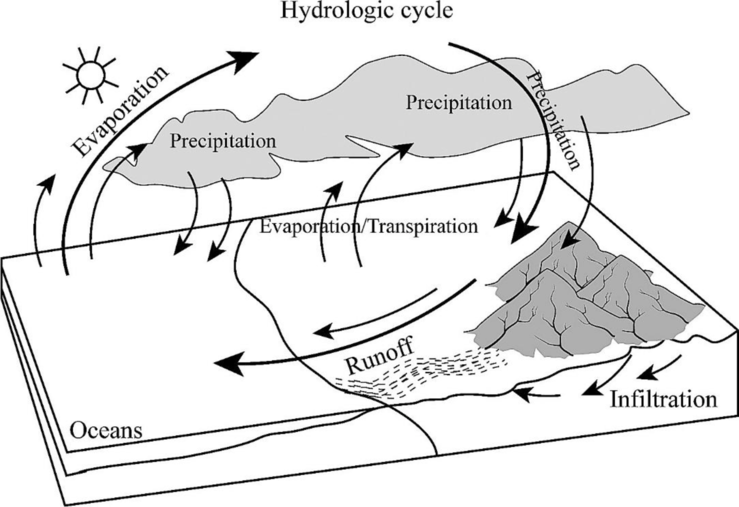
The main components of the hydrologic cycle using sketch.
Answer to Problem 1RQ

Hydrologic cycle represents the continuous movement of water through the oceans, the atmosphere, and the continents. It involves various processes such as evaporation, condensation, precipitation, runoff, transpiration, or evapotranspiration. The continuous movement of water that occurs through the hydrologic cycle has a key role in the distribution of moisture over the surface of the Earth and is intricately related to all occurrences on the atmosphere.
Explanation of Solution
The continuous movement of water through the oceans, the atmosphere, and the continents is referred as the hydrologic cycle. The evaporation of water present in the oceans and to a lesser extent from land areas occurs into the atmosphere. This moisture-laden air is transported by the wind often over large distances until condensation of tiny liquid cloud droplets during the process of formation of clouds.
The process of formation of clouds leads to precipitation. When the precipitation falls into the ocean, its cycle ended and another cycle is initiated, whereas a portion of the remaining precipitation falls over the land that penetrates into the ground through the process of infiltration and thereby groundwater is formed. The remaining amount of water that flows along the surface of the Earth is referred as runoff.
The process of evaporation finally returns much of the groundwater and runoff to the atmosphere. A less quantity of groundwater taken up by plants releases into the atmosphere through the process known as transpiration or evapotranspiration.
Want to see more full solutions like this?
Chapter 4 Solutions
THE ATMOSOPHERE-ETEXT
- N (120') -1180- (120') (105') 0 50 100 feet 1160- -1140- A (100') B (90') (80) Proposed well -1120. (95) (80°) (80') 1100 Well location (Depth to top of water table) A Figure 8.14 Hypothetical topographic map showing the locations of several water wells. The numbers in parentheses indicate the depth of the water table below the surface in each well.arrow_forwardDue tomorrow 3/27 2 pm if you could give me detailed solutions pleasearrow_forwardDue 3/27 at 2pmarrow_forward
- Based on the Climate-Change Censorship campaign article (WSJ) does the phenomenon of scientific certainty ever exist? Why or why not?arrow_forwardBased on the Climate-Change Censorship campaign article (WSJ) some think that twitter, snapchat, instagram, facebook, google, messenger, et al. are the new forums for public discourse. Should the big tech company owners of these sites be allowed to censor the information and comments posted by the public?arrow_forwardHow does radon enter a home?arrow_forward
 Applications and Investigations in Earth Science ...Earth ScienceISBN:9780134746241Author:Edward J. Tarbuck, Frederick K. Lutgens, Dennis G. TasaPublisher:PEARSON
Applications and Investigations in Earth Science ...Earth ScienceISBN:9780134746241Author:Edward J. Tarbuck, Frederick K. Lutgens, Dennis G. TasaPublisher:PEARSON Exercises for Weather & Climate (9th Edition)Earth ScienceISBN:9780134041360Author:Greg CarbonePublisher:PEARSON
Exercises for Weather & Climate (9th Edition)Earth ScienceISBN:9780134041360Author:Greg CarbonePublisher:PEARSON Environmental ScienceEarth ScienceISBN:9781260153125Author:William P Cunningham Prof., Mary Ann Cunningham ProfessorPublisher:McGraw-Hill Education
Environmental ScienceEarth ScienceISBN:9781260153125Author:William P Cunningham Prof., Mary Ann Cunningham ProfessorPublisher:McGraw-Hill Education Earth Science (15th Edition)Earth ScienceISBN:9780134543536Author:Edward J. Tarbuck, Frederick K. Lutgens, Dennis G. TasaPublisher:PEARSON
Earth Science (15th Edition)Earth ScienceISBN:9780134543536Author:Edward J. Tarbuck, Frederick K. Lutgens, Dennis G. TasaPublisher:PEARSON Environmental Science (MindTap Course List)Earth ScienceISBN:9781337569613Author:G. Tyler Miller, Scott SpoolmanPublisher:Cengage Learning
Environmental Science (MindTap Course List)Earth ScienceISBN:9781337569613Author:G. Tyler Miller, Scott SpoolmanPublisher:Cengage Learning Physical GeologyEarth ScienceISBN:9781259916823Author:Plummer, Charles C., CARLSON, Diane H., Hammersley, LisaPublisher:Mcgraw-hill Education,
Physical GeologyEarth ScienceISBN:9781259916823Author:Plummer, Charles C., CARLSON, Diane H., Hammersley, LisaPublisher:Mcgraw-hill Education,





